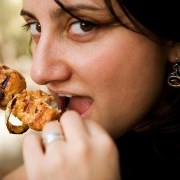 Photo: Getty Images
Photo: Getty Images
Have you heard of the Paleolithic diet that was once popular many years ago (get it?) and is coming back around due to its numerous health benefits? Also known as the primal, caveman or hunter-gatherer diet, the Paleo diet is an eating plan based on the foods available for humans to eat during the Paleolithic period, which was a time much before modern day agriculture. Therefore it relies on food that would have been hunted or fished, gathered, or picked.
There is so much processed food nowadays that many healthcare and nutrition professionals are encouraging their patients to look at their food from a simpler perspective. Consider all the fast food, frozen meals, and pre-packaged goodies eaten quickly during our day and washed down with a high sugar (or artificially sweetened) drink, it’s no wonder our society is wrecked with obesity, diabetes, digestive complaints like irritable bowel, fatigue and other chronic diseases and symptoms. To pull a quote directly from Therapeutic Advances in Cardiovascular Diseases, “The transition from the Paleolithic diet to our modern diet has produced an epidemic of nutritionally related diseases including hypertension, atherosclerosis, coronary heart disease, myocardial infarction, congestive heart failure, cerebrovascular accidents, renal insufficiency, renal failure, type 2 diabetes mellitus, metabolic syndrome and obesity.”
The Paleo diet consists of lean protein (preferably grass-fed and free of hormones), fruits and vegetables in season, with some healthy fats such as unsalted nuts and seeds, avocado, and maybe olive oil. They eliminate foods not available to the caveman or cavewoman such as all dairy products (that’s right, no milk, cheese, yogurt, or ice cream), grains (any grain including wheat or rice), beans, peanuts, and sugar. Many argue that it’s too low carbohydrate however the Paleo experts recommend a lot of vegetables, at every meal, to keep you healthy. And what is wrong with a lot of vegetables? Nothing, but the average American will eat several pieces of fruit daily and skip on their vegetable intake therefore missing out on important fiber and nutrients. Plus, fruit can be high in sugar and fructose which may exacerbate weight gain, blood sugar problems, and diabetes. This is something to be aware of.
Anecdotally, my patients that do a completely or mostly Paleo diet report that they feel better, have more energy, more mental clarity, are losing weight/inches, and have less inflammation in their body which might translate as less joint pain, less skin break-outs, less rashes, less gastrointestinal upset, and more. If you are looking to change your diet into one without all the processed foods, sugar, and potentially inflammatory foods like grains or dairy then educate yourself first and talk with your healthcare provider or nutritional consultant.
References:
1) The Role of Cellular Micronutrient Analysis, Nutraceuticals, Vitamins, Antioxidants and Minerals in the Prevention and Treatment of Hypertension and Cardiovascular Disease
http://www.medscape.com/viewarticle/724840
2) Origins and evolution of the Western diet: health implications for the 21st century
http://www.ajcn.org/content/81/2/341.full
3) The Paleo Solution
www.robbwolf.com
Reviewed August 5, 2011
by Michele Blacksberg R.N.
Edited by Jody Smith



Add a Comment1 Comments
The paleo diet is a diet system the basically removes starches from your diet. It's based on consuming lean meats, fruits and vegetables. It stems from the term "paleolithic era" which goes back millions of years where our ancestors were hunter gatherers. They did not have processed foods or preservatives or cultivated foods. There are 3 societies on earth today who basically eat this diet naturally and are documented to be the longest living people on the planet.
The paleo diet has been shown to help with heart disease, lower blood pressure, help with diabetes by helping with better insulin regulation and reduce lipid counts (triglycerides). To do this diet though you will need a good cookbook to change up any monotony you might experience.
August 16, 2011 - 1:21pmWant to learn more about The Paleo Diet, go to: paleo foods
This Comment